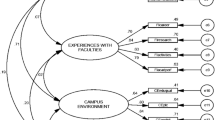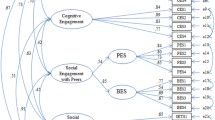Abstract
We sought to develop and psychometrically describe three new student engagement scales to measure college students’ engagement with their faculty (student-faculty engagement: SFE), community-based activities (CBA), and transformational learning opportunities (TLO) using items selected from the National Survey of Student Engagement (NSSE), a widely used, standardized student engagement survey. We used confirmatory factor analysis for ordered-categorical measures, item response theory (IRT), and data from 941 US college students’ NSSE responses. Our findings indicated acceptable construct validity. The scales measured related but separable areas of engagement. IRT demonstrated that scores on the student-faculty engagement scale offered the most precise measurement in the middle range of student-faculty engagement. The CBA scale most reliably measured above average engagement, while TLO scores provided relatively precise descriptions of engagement across this spectrum. Findings support these scales’ utility in institutional efforts to describe “local” student engagement, as well as efforts to use these scales in cross-institutional comparisons.










Similar content being viewed by others
Notes
The item did not differentiate course or non-course service.
Space constraints preclude presentation of the entire set. We will gladly share them upon request.
References
Astin, A. W. (1993). What matters in college: Four critical years revisited. San Francisco: Jossey-Bass.
Astin, A. W., & Sax, L. J. (1998). How undergraduates are affected by service participation. The Journal of College Student Development, 39(3), 251–263.
Astin, A. W., Vogelgesang, L. J., Ikeda, E. K., & Yee, J. A. (2000). How service learning affects students. Los Angeles: Higher Education Research Institute University of California.
Benjamini, Y., & Hochberg, Y. (1995). Controlling the false discovery rate: A practical and powerful approach to multiple testing. Journal of the Royal Statistical Society, Series B, 57, 289–300.
Bjorner, J. B., Smith, K. J., Stone, C., & Sun, X. (2007). IRTFIT: A macro for item fit and local dependence tests under IRT models. USA: QualityMetric Incorporated School of Education, University of Pittsburgh.
Carini, R. M., Kuh, G. D., & Klein, S. P. (2006). Student engagement and student learning: Testing the linkages. Research in Higher Education, 47, 1–32.
Chickering, A. W., & Gamson, Z. F. (1987). Seven principles for good practice in undergraduate education. AAHE Bulletin, 39, 3–7.
Crane, P. K., Gibbons, L. E., Jolley, L., & van Belle, G. (2006). Differential item functioning analysis with ordinal logistic regression techniques: DIFdetect and difwithpar. Medical Care, 44, S115–S123.
Cronbach, L. J., & Meehl, P. E. (1955). Construct validity in psychological tests. Psychological Bulletin, 52(4), 281–302.
Embretson, S., & Reise, S. P. (2000). Item response theory for psychologists. NJ: Lawrence.
Gonyea, R. M., Kinzie, J., Kuh, G. D., & Nelson Laird, T. F. (2008). High impact activities: What they are, why they work, and who benefits. Program presented at the American Association for Colleges and Universities annual meeting. Washington, DC.
Gordon, J., Ludlum, J., & Hoey, J. (2008). Validating NSSE against student outcomes: Are they related? Research in Higher Education, 49, 19–39.
Green, S. B., & Babyak, M. A. (1997). Control of type I errors with multiple tests of constraints in structural equation modeling. Multivariate Behavioral Research, 32(1), 39–51.
Hambleton, R. K., & Swaminathan, H. (1985). Item response theory. Boston, MA: Kluwer.
Hopkins, K. D. (1997). Educational and psychological measurement and evaluation. New York: Allyn & Bacon.
Hu, L., & Bentler, P. M. (1998). Fit indices in covariance structure modeling: Sensitivity to underparameterized model misspecification. Psychological Methods, 3(4), 424–453.
Hu, L., & Bentler, P. M. (1999). Cutoff criteria for fit indexes in covariance structure analysis: Conventional criteria versus new alternatives. Structural Equation Modeling, 6(1), 1–55.
Jones, R. (2006). Identification of measurement differences between English and Spanish language versions of the mini-mental state examination: Detecting differential item functioning using MIMIC modeling. Medical Care, 44, S124–S133.
Kinzie, J., Evenbeck, S. (2008). Assessing Student Engagement in High-Impact Practices. Program presented at the NASPA IARC Conference Scottsdale, AZ.
Klein, S. P., Kuh, G. D., Chun, M., Hamilton, L., & Shavelson, R. (2005). An approach to measuring cognitive outcomes across higher education institutions. Research in Higher Education, 46(3), 251–276.
Kuh, G. D. (2001). The national survey of student engagement: Conceptual framework and overview of psychometric properties. Bloomington, IN: Indiana University, Center for Postsecondary Research.
Kuh, G. D. (2003). What we’re learning about student engagement from NSSE. Change, 35, 24–32.
Kuh, G. D. (2005). 7 steps for taking student learning seriously. Trusteeship, 13, 20–24.
Kuh, G. D., Hayek, J. C., Carini, R. M., Ouimet, J. A., Gonyea, R. M., & Kennedy, J. (2001). NSSE technical and norms report. Bloomington, IN: Indiana University Center for Postsecondary Research and Planning.
Kuh, G. D., Kinzie, J., Schuh, J. H., Whitt, E. J., & Associates. (2005). Student success in college: Creating conditions that matter. San Francisco: Jossey-Bass.
McInnis, E. D. (2006). Nonresponse bias in student assessment surveys: A comparison of respondents and non-respondents of the national survey of student engagement at an independent comprehensive Catholic University. Unpublished doctoral dissertation, Marywood University, USA.
Muthén, L. K., & Muthén, B. O. (1998–2007). Mplus user’s guide. (4ed.) Los Angeles, CA: Muthén & Muthén.
National Survey of Student Engagement (NSSE). (2006). NSSE 2006 codebook. Retrieved November 22, 2009, from http://www.nsse.iub.edu/pdf/2006_Institutional_Report/nsse_codebooks/NSSE%202006%20Codebook.pdf.
National Survey of Student Engagement (NSSE). (2008). Origins. Retrieved November 22, 2009, from http://nsse.iub.edu/html/origins.cfm.
Orlando, M., & Thissen, D. (2000). Likelihood-based item-fit indices for dichotomous item response theory models. Applied Psychological Measurement, 24(1), 50–64.
Orlando, M., & Thissen, D. (2003). Further investigation of the performance of S-X²: An item fit index for use with dichotomous item response theory models. Applied Psychological Measurement, 27(4), 289–298.
Pace, C. R. (1984). Measuring the quality of college student experiences. Los Angeles: Los Angeles Center for the Study of Evaluation, University of California Los Angeles.
Pascarella, E. T., & Terenzini, P. T. (1991). How college affects students. San Francisco: Jossey-Bass.
Pedhazur, E. J., & Schmelkin, L. (1991). Measurement, design, and analysis: An integrated approach. Hillsdale, NJ: Lawrence Erlbaum Associates, Inc.
Pike, G. R. (2006a). The convergent and discriminant validity of NSSE Scalelet scores. Journal of College Student Development, 47, 551–564.
Pike, G. R. (2006b). The dependability of NSSE Scalelets for college- and department-level assessment. Research in Higher Education, 47, 177–195.
Samejima, F. (1969). Estimation of latent ability using a response pattern of graded scores. Psychometrika Monograph Supplement, 34(4, pt. 2), 100.
Stone, C. A. (2000). Monte carlo based null distribution for an alternative goodness-of-fit test statistic in IRT models. Journal of Educational Measurement, 37(1), 58–75.
Stone, C. A. (2003). Empirical power and type I error rates for an IRT fit statistic that considers the precision of ability estimates. Educational and Psychological Measurement, 63(4), 566–583.
Stone, C. A., & Zhang, B. (2003). Assessing goodness of fit of item response theory models: A comparison of traditional and alternative procedures. Journal of Educational Measurement, 40(4), 331–352.
Thissen, D., Chen, W., & Bock, D. (2002). MULTILOG 7. Chicago: Scientific software international.
Thissen, D., Steinberg, L., & Wainer, H. (1993). Differential item functioning. In P. W. Holland (Ed.), Detection of differential item functioning using the parameters of item response models (pp. 67–113). Hillsdale, NJ: Lawrence Erlbaum Associates.
Thorndike, R. M. (2004). Measurement and evaluation in psychology and education (7th ed.). Columbus, OH: Merrill Publishing Co/Prentice-Hall.
Acknowledgments
We would like to thank the students who participated in our University's National Survey of Student Engagement. We would also like to thank the reviewers whose comments improved our original manuscript. Finally, Adam would also like to thank Tara J. Carle and Margaret Carle whose unending support and thoughtful comments make his work possible.
Author information
Authors and Affiliations
Corresponding author
Rights and permissions
About this article
Cite this article
Carle, A.C., Jaffee, D., Vaughan, N.W. et al. Psychometric Properties of Three New National Survey of Student Engagement Based Engagement Scales: An Item Response Theory Analysis. Res High Educ 50, 775–794 (2009). https://doi.org/10.1007/s11162-009-9141-z
Received:
Accepted:
Published:
Issue Date:
DOI: https://doi.org/10.1007/s11162-009-9141-z




